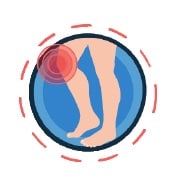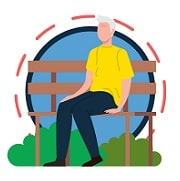Arthritis
In the United States, 21.2 % of all adults, or 53.2 million people, have arthritis. It is a leading cause of work disability, with annual costs for medical care and lost earnings of $303.5 billion in 2013.
The most common form of arthritis is osteoarthritis. Other forms include gout, rheumatoid arthritis, and lupus. Symptoms of arthritis are pain, aching, stiffness, and swelling in or around the joints. Rheumatoid arthritis and lupus can affect multiple organs and cause widespread symptoms.
More than half of US adults (51.7%) with arthritis are of working age (18 to 64 years). Arthritis can limit the type of work they are able to do or keep them from working at all. For example, they may have a hard time climbing stairs or walking from a parking deck to their workplace.
CDC conducts research and supports programs for people with arthritis so they can work and do other daily activities, have less pain, manage their own care, and prevent or delay disability.
In the United States:
CDC’s Approach
CDC collects arthritis data through the Behavioral Risk Factor Surveillance System and the National Health Interview Survey. These surveys provide information about:
- The number and percentage of adults who have arthritis.
- Whether the numbers or percentages are going up or down.
- How the disease affects people’s quality of life.
CDC’s Arthritis Program uses this information to guide public health decisions about the best ways to help adults with arthritis.

CDC recognizes several proven approaches to reduce arthritis symptoms:
- Participate in a self-management education program, such as the Chronic Disease Self-Management Program, that teaches the skills and confidence to live well with arthritis every day.
- Be active. Physical activity—such as walking, biking, and swimming—decreases arthritis pain and improves function, mood, and quality of life. Adults with arthritis should move more and sit less throughout the day. Getting at least 150 minutes of moderate-intensity physical activity each week is recommended. However, any physical activity is better than none. CDC-recommended physical activity programs can improve health for participants with arthritis.
- Maintain a healthy weight. People can reduce their risk of knee osteoarthritis by controlling their weight.
- Protect your joints. People can help prevent osteoarthritis by avoiding activities that are more likely to cause joint injuries.
- Talk with a doctor. Recommendations from health care providers can motivate people to be physically active and join a self-management education program. People with inflammatory arthritis, such as rheumatoid arthritis, have a better quality of life if they are diagnosed early, receive treatment, and learn how to manage their condition.
CDC collaborates with a variety of state and national partners to expand the dissemination and delivery of proven arthritis self-management education and physical activity programs and sustain them over time. Since 2012, these partners have reached over 300,000 adults across all 50 states, American Samoa, and Puerto Rico with these programs.
Twelve U.S. states use CDC funding to expand the ongoing reach of these evidence-based programs. States also use CDC funding to increase health care provider counseling about the benefits of physical activity for arthritis management, promote walking, and encourage referral of patients with arthritis to proven intervention programs.
For example, in 2022, musculoskeletal conditions (including lower back pain, joint pain and osteoarthritis) impacted 33% of covered state employees, retirees, and dependents in New Hampshire and accounted for ten percent of total medical health care costs. In response, the New Hampshire Arthritis Program partnered with the state Department of Administrative Services to offer Walk With Ease Self-Directed and Self-Directed Enhanced programs to all covered members as part of their worksite wellness benefits.
CDC also works with national organizations to expand the use of physical activity evidence-based interventions for adults with arthritis. For example, the National Recreation and Park Association has supported local park agencies in 48 states and American Samoa to deliver the Arthritis Foundation Exercise Program, Active Living Every Day, Fit & Strong!, or Walk With Ease program.
Another national organization partner, The Osteoarthritis Action Alliance (OAAA) helped expand access to the Self-Directed Walk With Ease program by creating a portal that allows people to participate at their own pace. OAAA also worked with CDC, the Arthritis Foundation and other partners to develop A National Public Health Agenda for Osteoarthritis: 2020 Update, a guide for using strategies across various sectors to improve the quality of life for adults living with arthritis and other chronic conditions.




